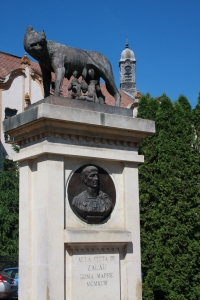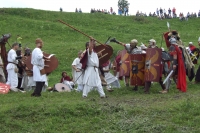In 2005 it was Zalău City Hall's and Local Council's initiative to organize the first edition of the Roman Festival. The reason of creating this event was the willingness of the local government to offer the public a high quality event that would singularize among other local, regional and national events.
Organising the first festival of reenactment focused on antiquity was also an opportunity to promote Zalău while the city is experiencing a lack of visibility at the national level.
From the very beginning the promoters were decided to make the festival known at the European level. Starting from the first edition, the Festival had an international participation. The number of Romanian reenactment associations (troups), participating in the Festival increased throughout the years. Local associations have also been created.
The main challenge of the organizers is to increase the rate of interactivity, mainly by involving an increased number of citizens of Zalău. An ordinary Roman or Dacian costume can metamorphose any viewer from a passive one to an active actor and into an inhabitant of the antiquity.
The Roman Festival itself is an invitation to travel back in time, an invitation to everyone irrespective of his/her age.
The Festival enjoyed a restoring process of its image. The original name was the Festival of Roman Days. The picture of "Porta Prateoria" from the Porolissum archeological site was used as logo. In 2010 the event was renamed as Festivalul Roman Zalău Porolissum - Zalau Porolissum Roman Festival and the logo changed into the image of Roman centurion's head. In 2010, Municipality had the initiative to register the brand to OSIM (the Romanian organization responsible for issuing trade marks). In 2011, the certificate was issued with no. 111826.
Where is held the Roman Festival?
The Roman Festival is held in both Zalău and the Roman Castrum Porolissum (Moigrad village, 10 km away from Zalău).
The garden of the National College "Silvania" has already become the traditional place for holding it. The College is located in the center of the city (1 Unirii St, next to the Sălaj County Museum of History and Art).
As regarding the Roman Castrum Porolissum, it is located next to Moigrad (Mirşid commune), 13 km away from the North East of Zalău. The local public transport company along with the Municipality assures the transportation from Zalău to the spot on the day the festival is held at Porolissum.
When is held the Festival?
Beginning with 2012, the Festival is programmed to carry on in September. This modification has been made recently in the structure of the event. Up to now, the Festival was carried on during the same period with the Days of Zalău (the city's celebration). This dissociation is caused by the different traits of the 2 events. The intention of the organizers is also to highlight and promote the Festival with a greater success at the regional, national and international level.
In 2012, the Festival will be organized in September 21 and 22.
What the Festival consist in?
During 2 or 3 days Zalău transforms itself into a large Roman camp. Soldiers, gladiators, vestals, dancers, citizens of the ancient Roman Empire can be encounter walking in the streets of Zalău. Fight demonstrations of Roman legions and cohorts are opportunities to touch and experience ancient history. The fight equipment is a reality; the viewers can benefit of a real lesson on antiquity. There are reenactments of fights between Romans and so called barbarians, either Dacians or other peoples.
Those interested in the ordinary day life of a Roman citizen, the introducing of the gladiator's school might be attractive. More than that, the viewers can decide at the end of a fight upon the destiny of the defeated gladiator. Dance and drama shows, handicrafts and gastronomy complete the spectacle. And if you are still not convinced by all these, you can try getting married in the Roman style.
The Roman Festival is a time travel experience, an opportunity to learn about the history of one of the greatest empires of the world. The event has a pronounced educational and interactive trait that differentiates it with respect to other mass events. Today a trade mark for Zalău, in future it will become a regional brand capable to attract tourists and create multiplying effects, as it has already happened.
Who attends?
The participants in the events are cultural associations of historic reenactment, specialized on ancient history. Lately the number of reenactment groups is increasing in Romania, even in Zalău. More, the offer of these associations is becoming more diverse.
Up to now, the Festival enjoyed the presence of the following groups:
- Savaria Legio XV Apollinaris (from Szombathely, Hungary): 2005, 2006, 2007, 2008, 2009, 2011
- Terra Dacica Aeterna (from Cluj Napoca, Romania): 2008, 2009, 2010
- Cohorts III Campestris (from Zalău, Romania): 2011
- The Fighters from Porolissum (from Zalău, Romania): 2011
- Virtus Antiqua (from Cluj Napoca, Romania): 2011
- Collegium Gladiatorium (from Budapesta, Hungary): 2008
- Familia Gladiatoria Pannonica (from Germany): 2007, 2008
- Knights of Mediaș (Sibiu, Romania): 2006
- Dacian Frairies (from Zalău, Romania): 2005, 2006, 2007, 2008, 2009, 2010, 2011
- The Trei Parale Music Band (from București, Romania): 2007
- The Wolves of Dacia (from Zalău, Romania): 2011
- Menestrelii Music Band (from Șimleu Silvaniei, Romania): 2009
- Naghual Music Band (from Oradea, Romania): 2008
- Flame Out Band (from Oradea, Romania): 2008
- Double X and Pajura Stunt Association (from Târgu Mureș, Romania): 2007
- National Theatre Cluj (from Cluj Napoca, Romania): 2007
- Aeternum Music Band (from Sibiu, Romania): 2006
- Truverii Music Band (from București, Romania): 2006
- Blackbeers Band (from Oradea, Romania): 2006
- Crispus Band (from Sibiu, Romania): 2006
The Festival Timetable
The 2005 edition was the first carried on during July 29 - 31 in Zalău and at Porolissum site under the name the Roman Days Festival. The center of the Zalău was set-up just like a real Roman city. A wooden gate was set on the Mihai Viteazu Boulevard. At the entrance of the Municipal Park a Roman tavern was created where traditional food was served. Craftsmen like stone breakers, blacksmiths and potters showed their abilities. An attraction was the Wine Story, a genuine exhibition of the artist Flavius Lucăcel. 2005 was the year of establishing the cooperation, still valid today, of Zalău Municipality with Legio XV Apollinaris, a cultural association from the old roman city Savaria (nowadays Szombathely, Hungary). The presence of the Roman Legion was unique as the organized camp was established exactly in the archeological site of Porolissum (Moigrad village, Mirşid commune). The legionaries lived for two days like genuine roman soldiers, sleeping on straw beds, eating food cooked in the camp and wearing Romans clothing and outfits. It was for the first time in 2000 years the Roman Castrum in Porolissum was occupied by legionaries.
In 2006 the Festival was organized during June 30 - July 2, in Zalău and Porolissum. The number of groups increased. Besides Legio XV Apollinaris, Familia Gladiatoria Pannonica and The Knights of Mediaș and other assemblies were participating in the event. There were magicians and fire juggle shows, Celtic and medieval music, pantomime and dance. A new ancient handicrafts exhibition was set up. Fight demonstrations with replica of military equipment, tournaments and medieval fight with swords, old Romanian rites, all these were presented to the public.
In 2007, the Festival was held over June 15 - 17. The novelty of the third edition was the participation of National Theatre from Cluj Napoca with a performance from the antique authors. As in the previous years, Legio XV Apollinaris and Familia Gladiatoria Pannonica were there. Besides the years before, the military camp was set in the garden of "Silvania" National College. The location of the garden gives a more facile access to the military camp. Ancient music, magicians, fire juggle shows, antique drama and dance with Zalău Fairies were brought to the public. Exhibitions and conference were opened to public.
In 2008, The Roman Festival was held between August 2 and 3. The novelty of this edition was the participation of a reenactment associaation Terra Dacica Aeterna coming from Cluj Napoca. It was a sign for the organizers that events of antique topic are more and more successful to the public. Other performers on the scene were Legio XV Apollinaris and Familia Gladiatoria Pannonica, Zalău Fairies. Fight demonstrations shows, between Dacians and Romans, gladiators' fights, riding horses, not to mention drama shows, dance performance and also buried ritual all those performances attracted the viewers.
In 2009, the Roman Festival took place in 1 and 2 August. At the initiative of the County Museum of History and Art the local group Cohort III Campestris from Porolissum was created. The Festival became more and more independent from international assemblies. As it happened a year before, the Romans camped in the garden of Silvania National College.
In 2010, due to some infrastructure works at the site allotted for holding the event, the Festival developed in Pădurea Brădet Park. Terra Dacica Aeterna performed. The members of the assembly dressed like the ancient Dacians and Romans set up a real show of life and death. The genuine of the costumes and equipment, the skills of the fighters as well as the natural surroundings created a valuable show. Given to the previous years, children were offered the opportunity for riding the two horses included in the program. The little ones enjoyed very much the experience.
In 2011, the antique life show moved back into the garden of "Silvania" National College. A Roman wedding had been set up for a couple that married the same day at the City Hall. As both were passionate by the ancient history, they decided to give some antique color to the official ceremony. Even the participants to the wedding, including the mayor, were dressed in antique clothes. The parade of the costumes was led by the happy couple and blessed by the Fairies. Other attractions were the fight demonstrations and introductory moment of Virtus Antiqua Association Gladiators School program, an association coming from Cluj Napoca. Another show of interest for the viewers was the presence of Porolissum Fighters, from Zalau. Their spectacular performance included stunts. We have to mention that the number of participants to the parade was higher than ever, among them were many children including The Wolves of Dacia.





















 Subscribe via RSS
Subscribe via RSS

